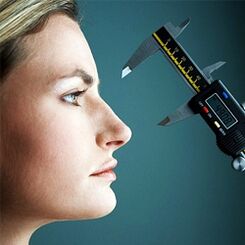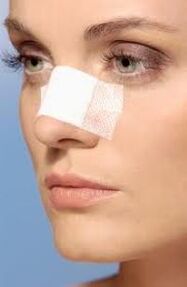The nose is the most visible part of the face, and it is its shape and general appearance that determine how others will perceive a person. Many of us are dissatisfied with our noses: some do not like their size or shape, others suffer from a hump or wings that are too wide, and still others want to fix the tip of the nose that is sticking up or falling down. All of these problems are easily resolved, to the delight of patients, with the help of one of the oldest plastic surgeries - rhinoplasty.
Rhinoplasty- Surgery to correct (change) the shape or size of the nose in order to improve its appearance, eliminate problems with nasal breathing and create a mentally comfortable state for the patient.
Types of Rhinoplasty
Differentiate between aesthetic and reconstructive rhinoplasty.
The main goal of aesthetic rhinoplasty is to correct the "flaw" of nature by changing the shape or size of the nose and thus giving the face a more harmonious and attractive appearance. Aesthetic rhinoplasty can be either full or superficial (partial).
Complete rhinoplasty is a plastic surgery in which the surgeon touches all structural parts of the so-called outer nose: bone tissue, cartilage tissue, as well as soft tissue. Such an operation is indicated for patients who want to reduce the length or width of the nose, change the shape of the saddle, and remove the hump.
A partial (or superficial) rhinoplasty is an operation to correct (change) the shape of the nose when the surgeon only works on some of the outer parts of the nose without affecting bone tissue. Partial rhinoplasty is done when the tip of the nose needs to be corrected or the wings need to be reduced. However, a full nose job may also be required to get rid of such problems. The doctor decides this after the examination and discussion with the patient.
Reconstructive rhinoplasty is primarily aimed at solving a problem such as eliminating difficulty breathing due to the curvature of the nasal septum or the hypertrophy of the turbinates. Reconstructive rhinoplasty is the process of restoring the appearance of the nose that has been damaged (for example, "slipped sideways" due to a fracture) and partially or completely lost due to an injury. This type of surgery is used when it is necessary to correct the congenital deformity of the osteochondral skeleton in the nasal area. Sometimes a plastic surgeon literally needs to "sculpt" a new nose using the auricular cartilage or cartilage (in particularly severe cases) as well as artificial materials.
Often the patient does not need surgery so much for cosmetic and aesthetic reasons, but rather to restore normal breathing that was impaired due to the deformation of the nasal septum during the trauma. Typically, post-traumatic surgery includes nasal plastic surgery and septoplasty (an operation to correct the nasal septum, the main goal of which is to restore normal nasal breathing).
Preparation for the rhinoplasty

Before deciding on an operation, the patient, together with the plastic surgeon, discusses the future parameters and the appearance of the nose, determines what exactly the patient wants to achieve, and the end result is simulated with the help of a computer. This approach helps "try" the new nose on the patient's face prior to surgery, ensuring that its new appearance does not violate the overall proportions of the face and that the shape of the nose blends in with all facial features.
It should also be borne in mind that if the patient has not reached the age of 17-18, rhinoplasty is not performed. This is due to the growth of the body and the formation of cartilage and bony skeleton. The consequences of having a nose job at an earlier age can be unpredictable. However, it is preferable to resort to a rhinoplasty no earlier than 21 years of age - doctors say that it is by this age that the bony skeleton has finally formed.
Features of rhinoplasty
Rhinoplasty is considered one of the most difficult plastic surgeries: after all, it is important not only to change your nose and give it the size or shape you want, but also not to interfere with nasal breathing. Therefore, such an operation should only be performed by an experienced specialist who has already proven himself and has good patient reviews.
Rhinoplasty can be performed with both open and closed access. Open Access involves a skin incision from the outside that is almost invisible at the end. With a closed access, the surgical procedure is carried out from the side of the nasal mucosa (through the nostrils) without external incisions and leaves no traces. A closed nose job is considered more difficult and requires the special skills of a plastic surgeon.
The type of access is determined directly at the consultation and depends on many factors: the shape of the nose, the features of its structure and the desired end result. Surgery to correct the size or shape of the nose is performed under local or general anesthesia: the choice of anesthesia is influenced by the complexity of the surgical procedure and the duration of the proposed operation. . . . In any case, the patient gets rid of the pain completely and does not feel uncomfortable.
Post-operative time

Rhinoplasty is a serious surgical procedure that requires not only the professional approach of the doctor, but also the responsibility of the patient himself during the rehabilitation period. The postoperative period is painless. Only in the first few days, tampons that make it difficult for the nose to breathe, bring some discomfort to the patient.
A fixing patch is placed on the nose, which is removed from time to time for skin care. In general, wearing such a bandage is mandatory for 7-10 days. During this time, the primary edema usually goes away, and bruises and puffiness under the eyes go away. The remaining subcutaneous induration, which is almost invisible to others, disappears completely within 6-8 months. After this time, the final result of the rhinoplasty will be visible.
Usually the patient is discharged the next day after the operation, but remains under the supervision of a doctor and comes to the clinic for an examination and bandage. The process of general recovery after a nose job takes about a month. During this time, the patient must wear a special bandage in the area of the nose, as well as restrict physical activity and eliminate bad habits (smoking, alcohol consumption).
A patient who has undergone a rhinoplasty must undergo a mandatory examination with a plastic surgeon 3, 6, and 12 months after the operation.
Contraindications to rhinoplasty
An experienced plastic surgeon will refuse to perform the operation if the patient has a history of:
- Diseases of the cardiovascular system;
- Bleeding disorders;
- chronic diseases of the liver and kidneys in the acute stage;
- oncological diseases;
- Infectious diseases;
- Mental illness.
Of course, rhinoplasty is a serious step in the life of someone who dreams of changing their nose and at the same time changing their life. But many of us understand it very well: if any - even significant - figure flaws can be "camouflaged" or even turned into advantages with the help of clothing, then an ugly nose is the first thing others look for when they look into a person'sFace. And if this very nose is too big or too humped, such a "spectacle" can in no way be hidden, it will always spoil the appearance and mood. Therefore, sometimes you need to opt for surgery and correct the shape or size of the nose than to suffer all your life and sigh every time you look at yourself in the mirror.






















